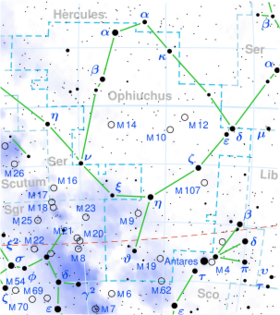Astronomy:30 Ophiuchi
| Observation data Equinox J2000.0]] (ICRS) | |
|---|---|
| Constellation | Ophiuchus |
| Right ascension | 17h 01m 03.60142s[1] |
| Declination | −4° 13′ 21.5308″[1] |
| Apparent magnitude (V) | 4.82[2] |
| Characteristics | |
| Spectral type | K4III[3] |
| U−B color index | +1.80[4] |
| B−V color index | +1.48[4] |
| Astrometry | |
| Radial velocity (Rv) | −6.70[5] km/s |
| Proper motion (μ) | RA: −39.13[6] mas/yr Dec.: −78.09[6] mas/yr |
| Parallax (π) | 9.3138 ± 0.1676[1] mas |
| Distance | 350 ± 6 ly (107 ± 2 pc) |
| Absolute magnitude (MV) | −0.65[2] |
| Details | |
| Radius | 35.89+0.54 −2.12[1] R☉ |
| Luminosity | 299.8±6.2[1] L☉ |
| Surface gravity (log g) | 1.73[7] cgs |
| Temperature | 4,009.00+126.67 −29.67[1] K |
| Metallicity [Fe/H] | −0.03[2] dex |
| Rotational velocity (v sin i) | 1.4[8] km/s |
| Other designations | |
| Database references | |
| SIMBAD | data |
30 Ophiuchi is a single[10] star in the equatorial constellation of Ophiuchus, and figures 0.99° east (specifically E½S) of the heart of cluster Messier 10.[11] It is visible to the naked eye as a faint, orange-hued point of light with an apparent visual magnitude of 4.82.[2] The distance to this star is approximately 350 light years based on parallax.[6] Its present motion is, net, one of approaching rather than parting, at −6.7 km/s, its "radial velocity".[5]
This is an aging giant star with a stellar classification of K4III,[3] having exhausted the supply of hydrogen at its core and expanded to 36[1] times the Sun's radius. It is a suspected variable star.[12] The star is radiating 300[1] times the luminosity of the Sun from its swollen photosphere at an effective temperature of 4,009 K.[1] It is emitting a far infrared excess due to circumstellar dust,[13] which extends out to a diameter of 240 astronomical unit|AU and has a mass of 62×1025 g.[14]
The primary presents with two visual companions: B, at magnitude 9.71 and separation 99.8″, and C, at magnitude 8.75 and separation 220.9″ (3′ 40.9″).[15]
References
- ↑ 1.0 1.1 1.2 1.3 1.4 1.5 1.6 1.7 1.8 Brown, A. G. A. (August 2018). "Gaia Data Release 2: Summary of the contents and survey properties". Astronomy & Astrophysics 616: A1. doi:10.1051/0004-6361/201833051. Bibcode: 2018A&A...616A...1G. Gaia DR2 record for this source at VizieR.
- ↑ 2.0 2.1 2.2 2.3 Anderson, E.; Francis, Ch. (2012). "XHIP: An extended hipparcos compilation". Astronomy Letters 38 (5): 331. doi:10.1134/S1063773712050015. Bibcode: 2012AstL...38..331A. Vizier catalog entry
- ↑ 3.0 3.1 Hoffleit, D.; Warren, W. H. (1995). "VizieR Online Data Catalog: Bright Star Catalogue, 5th Revised Ed. (Hoffleit+, 1991)". VizieR On-line Data Catalog: V/50. Originally Published in: 1964BS....C......0H 5050. Bibcode: 1995yCat.5050....0H.
- ↑ 4.0 4.1 Mallama, A. (2014). "Sloan Magnitudes for the Brightest Stars". The Journal of the American Association of Variable Star Observers 42 (2): 443. Bibcode: 2014JAVSO..42..443M.Vizier catalog entry
- ↑ 5.0 5.1 Gontcharov, G. A. (2006). "Pulkovo Compilation of Radial Velocities for 35 495 Hipparcos stars in a common system". Astronomy Letters 32 (11): 759–771. doi:10.1134/S1063773706110065. Bibcode: 2006AstL...32..759G.
- ↑ 6.0 6.1 6.2 Van Leeuwen, F. (2007). "Validation of the new Hipparcos reduction". Astronomy and Astrophysics 474 (2): 653–664. doi:10.1051/0004-6361:20078357. Bibcode: 2007A&A...474..653V. Vizier catalog entry
- ↑ Soubiran, Caroline; Le Campion, Jean-François; Brouillet, Nathalie; Chemin, Laurent (2016). "The PASTEL catalogue: 2016 version". Astronomy & Astrophysics 591: A118. doi:10.1051/0004-6361/201628497. Bibcode: 2016A&A...591A.118S.
- ↑ De Medeiros, J. R.; Alves, S.; Udry, S.; Andersen, J.; Nordström, B.; Mayor, M. (2014). "A catalog of rotational and radial velocities for evolved stars". Astronomy & Astrophysics 561: A126. doi:10.1051/0004-6361/201220762. Bibcode: 2014A&A...561A.126D. Vizier catalog entry
- ↑ "30 Oph". SIMBAD. Centre de données astronomiques de Strasbourg. http://simbad.u-strasbg.fr/simbad/sim-basic?Ident=30+Oph.
- ↑ Eggleton, P. P.; Tokovinin, A. A. (September 2008). "A catalogue of multiplicity among bright stellar systems". Monthly Notices of the Royal Astronomical Society 389 (2): 869–879. doi:10.1111/j.1365-2966.2008.13596.x. Bibcode: 2008MNRAS.389..869E.
- ↑ O'Meara, Stephen James (1998). Deep-Sky Companions: The Messier Objects. Cambridge University Press. p. 63. ISBN 9780521553322. https://books.google.com/books?id=jis4evHuuzUC&pg=PA63.
- ↑ Samus, N. N. et al. (2017). "General Catalogue of Variable Stars". Astronomy Reports. 5.1 61 (1): 80–88. doi:10.1134/S1063772917010085. Bibcode: 2017ARep...61...80S.
- ↑ Zuckerman, B. et al. (June 1995). "Luminosity Class III Stars with Excess Far-Infrared Emission". Astrophysical Journal Letters 446: L79. doi:10.1086/187935. Bibcode: 1995ApJ...446L..79Z.
- ↑ Jura, M. (April 1999). "Dust around First-Ascent Red Giants". The Astrophysical Journal 515 (2): 706–711. doi:10.1086/307064. Bibcode: 1999ApJ...515..706J.
- ↑ Mason, Brian D.; Wycoff, Gary L.; Hartkopf, William I.; Douglass, Geoffrey G.; Worley, Charles E. (2001). "The 2001 US Naval Observatory Double Star CD-ROM. I. The Washington Double Star Catalog". The Astronomical Journal 122 (6): 3466. doi:10.1086/323920. Bibcode: 2001AJ....122.3466M. Vizier catalog entry
 |


